- Bernard Preston homepage
- Solar
- Solar Powered Generator
Solar powered generator
Building a solar powered generator is a serious project, big or small for anyone
who is able with his hands; and has at the very least a full high-school
background in physics.
This page was last updated by Bernard Preston on 18th September, 2024. At this time of writing, failure of the grid is no longer a daily affair in South Africa; but in many areas it fails whenever it rains.
There were few more important decisions at our green home than the one we made fourteen-years ago to build a solar powered generator. Apart from anything else it has enabled us to escape the stress and anger seen on so many faces when there is no electricity.
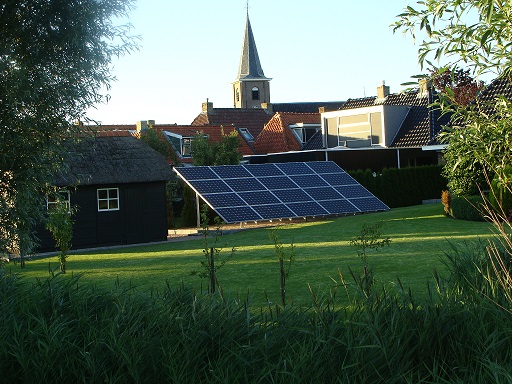
With the world's population expected to grow by one-third to more than nine billion by the year 2050, we will need the following.
- 70 percent more energy
- 55 percent more fresh water
- United Nations
If I was to do it all again, I'd try and build my panels on the ground like these that I spied in a small fishing-village in Holland; but they are in early morning shade.
Perhaps the very best option is to construct a new workshop, its roof dedicated to your solar powered generator. 60% of the panels would be facing due south (in the Northern hemisphere), with 20 percent to the east to catch the morning sun; and another fifth directed to the west. The home's greatest electrical needs are not at midday.
As you will read below this building of a solar farm has become something of a saga; never did I realise how I would fall in love with free energy from the sun. If I was you, if you can afford it, go big from the beginning.
I wish I had. I've yet to meet anyone satisfied with a Mickey-Mouse solar powered generator.
I've just increased my solar residential panels by adding four more larger PVs, 185W each, two more batteries and upgraded to a 5 kilowatt inverter. Now we should never need grid electricity for our basic needs; provided the sun is shining brightly.
Now I'm about to add yet four more 235 watt panels but it makes for complications. Go as big as you can afford from the beginning, and use the same size PVs if possible.
Why spend all this money on solar?
There are any number of reasons why you might want to go for solar power at home. Perhaps it's a consuming passion for the environment; most sources of energy are provided from dirty-fuels like coal, uranium and oil.
Or perhaps, like me, you live in an area where the
electricity is increasing unreliable. Sudden unexpected losses from the grid
do interesting things to computers and a solar generator, for one,
provides a reliable uninterrupted power-supply, or UPS.
Sudden losses of electricity can also be very distressing for the home and business. We started regularly losing mains power when the bread-machine was busy and the good wife would fume; no loaf today and a wasted lump of dough. That's small beer compared to the effect on industry; everywhere people are buying petrol-driven generators but, for my money, use of Mr Golden Sun is a better option.
Building your own solar powered generator could also be where you would cut your teeth for your next career. The clean energy sector is where the growth is, whether it's erecting PV panels, windmills or water turbines; or even battery electric vehicles.
"We do not have to pay for wind and sun; the feedstock will come free."
- Michael Power
Total blackout is now a serious possibility in South Africa; it would apparently take two whole weeks to reboot the grid from a so-called cold start.
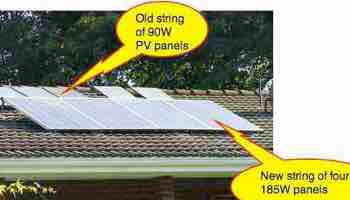
If I was to build another solar powered generator, with hindsight, I would not put it on the roof. Why, you may very well ask? That's the way everyone does it; true but at residential solar panels pitch you will find there is a better way.
- Could a total blackout really happen?
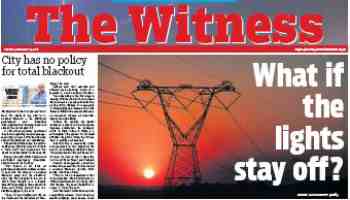
Or whilst I was in the midst of treating patients, loss of power would render my equipment useless; then it was my turn to sulk.
I have just lost a whole hour's work whilst building a page for this site on lettuce wraps recipes when the mains tripped; yes, serves me right, I hear you saying. I should save my work more frequently but sometimes one becomes engrossed; in future this computer will be working only off solar. Even with the odd cloudy day the sun is more reliable than our electrical utility.
No matter how limited your physics background is, you probably have a vague idea that the sun radiates the earth with energy. These joules come in small bundles called photons; they have a wave pattern with different frequencies.
Some is in the light frequency range, and another in the infrared spectrum which can be used to heat water, for example; also ultraviolet that damages the skin and even more toxic gamma rays in very small quantities.
Most of this energy is gathered by green plants to convert sunshine by a process called photosynthesis into usable sugars in the leaves; hence the global concern at deforestation and the loss of species that is happening at a frightening rate.
The world is on a suicide mission generally known as uncontrolled expansion, as terminal as Elon Musk's mission to Mars; soon we will reach the point of no return unless more of us build solar powered generators.
"A goal without a plan is just a wish."
Antoine de Saint Exupery
Loss of power for eight hours last Christmas eve was the final straw.
We made the decision to change over to gas cooking and home solar power
for fridge, computers and lights. Even the electric oven, which draws only 2kW can be connected to the inverter, using a change over switch; that allows you to simply toggle back and forth from the utility.
So, how does solar energy work?
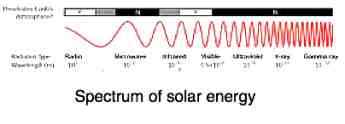
Radio waves on the left have low energy (frequency) but gamma ray photons are very destructive having a high frequency (low wavelength) causing many of the genetic mutations that are so prevalent.
Most of these waves will activate your solar panels, but the infrared portion (the heat photons) are filtered out by cloud. But even on a cloudy day, quite a lot of photons will get through and activate the solar panels.
Home solar power
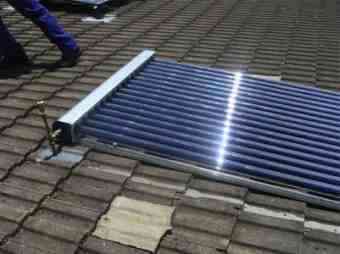
Your home solar power programme should first and foremost be to capture the infrared (heat) part of the spectrum. Providing free hot water is the most effective (and cheapest) way to capture the sun's energy. It contributes about half of your home carbon footprint.
Solar powered generator
Now to the main part of this page; building your own solar powered generator. Firstly, make sure you understand the process; really it's not rocket science. Walk with me, one step at a time, and you will get it. Along the way, expect to ask your kid some questions about watts, or the formula for heat losses in a wire; and so on.
Two roads lead to the solar utopia.
You can go about building a solar powered generator in two ways, depending on your interest, knowledge and skills. Firstly you can pay someone a lot of money to set it all up for you. There are electrical engineers who will do it do it very effectively and properly but as always, do your homework; shop around and talk to people.
Secondly you could build your own solar generator yourself. You will save a lot of money and have a lot of fun but if you don't do it properly, you could electrocute yourself. DC current doesn't let go.
It's been said many times that an amateur with the will to learn and work hard can build a house. But it takes a professional to erect a bridge across the highway.
Setting up your own solar powered generator falls somewhere in between. You could do it. I did with only a little background but you do have to learn about the process first; and will require help along the way most likely.
The first rule is to start as big as you can afford from the beginning.
You can build a small, relatively inexpensive solar powered generator that will just run your lights and computers. But if my experience is anything to go by, once hooked on solar and all that free energy coming from the sun, you'll start thinking. What about the fridge? Could I use an electric drill and the vacuum cleaner? What about the bread maker, the coffee machine and the induction cooktop stove?
Even hot water kettles and modern ovens draw only about two kilowatts which is not beyond an inverter. But the hob should be gas and your geyser energised by solar tubes; or extra PV panels.
Here's an update, however. There are now hot water geysers on the market that can be powered directly by photovoltaic panels. It is done using induction and requires less than half the electricity of the conventional element. It certainly is an option; in fact we are now with surplus energy from the PVs to top up.
Newsletter
Our newsletter is entitled "create a cyan zone" at your home, preserving both yourself and Mother Earth for future generations; and the family too, of course. We promise not to spam you with daily emails promoting various products. You may get an occasional nudge to buy one of my books.
Here are the back issues.
- Lifestyle and ideal body weight
- What are ultra-processed foods?
- Investing in long-term health
- Diseases from plastic exposure
- Intensive lifestyle management for obesity has limited value
- A world largely devoid of Parkinson's Disease
- The impact of friendly bacteria in the tum on the prevention of cancer
- There's a hole in the bucket
- Everyone is talking about weight loss drugs
- Pull the sweet tooth
- If you suffer from heartburn plant a susu
- Refined maize meal and stunting
- Should agriculture and industry get priority for water and electricity?
- Nature is calling
- Mill your own flour
- Bake your own sourdough bread
- Microplastics from our water
- Alternative types of water storage
- Wear your clothes out
- Comfort foods
- Create a bee-friendly environment
- Go to bed slightly hungry
- Keep bees
- Blue zone folk are religious
- Reduce plastic waste
- Family is important
- What can go in compost?
- Grow broad beans for longevity
- Harvest and store sunshine
- Blue zone exercise
- Harvest and store your rainwater
- Create a cyan zone at your home
Also clouds readily block off the infrared heat but far more light energy gets through; they are more effective on inclement days than vacuum tubes.
The two parts that are not easy to change are the regulator, known as a maximum power point tracker, and the inverter.
More about what they are, and what their functions are later but, at the very initial stage, go as big as you can afford; upgrading later is a costly business.
Consider also a grid tied inverter which enables
you to sell your excess power to your utility provider; if they will
buy it. They are getting more sticky about the surplus solar energy that home owners are producing. And if you have a dirty grid like we have in South Africa you may get surges and brown-outs.
My thoughts are to go at least for a sixty amp regulator and a five
kilowatt inverter. You can always add more
panels, but upgrading these two babies is an expensive business. If you
go big in the beginning, it hurts only once.
So, here's the deal.
- Photons of sun energy are arriving at the earth's surface on a daily basis, and you can capture them using a photo voltaic cell. As the term suggests the panel converts them into usable power with a known voltage, usually between 15 and 45V. You will probably have an array of them, three or more; and up to several dozen.
- This energy from these photo voltaic panels is coming in the form of direct current. It is carried along two copper cables to a regulator, known as a maximum power point tracker. Forget the term, but it's more efficient and worth getting.
- More information on the relatively simple installation of photovoltaic panels for your solar generator can be found below.
There are electrical losses in all conducting cables; some of your solar power is lost as heat.
It's inevitable but, to minimise these lost watts, you want to have your photovoltaic panels as close to the regulator as possible.
How close should that be? Well that depends on how thick your cabling is, and how high the voltage from your PV panels is. Of course it's also determined by which area of your roof receives the most sunshine, and particularly early morning sun. If your voltage is 100V or more, don't get too phased about those losses.
I started with six small 16 volt panels in series totally about one hundred volts. That cable needs to be quite thick; I am using 10mm cabling in our home because the distance has to be greater than normal in our situation; about 25m. Nearer to the regulator the roof is in shadow from large trees for quite long periods in the morning in winter.
In the end, it is worth buying as thick a cable for your solar powered generator as you can afford. It's a once off cost and will minimise your losses.
Solar powered generator
Solar powered generator is a gimmick only for greenies, you may think, or can one really collect enough free energy from the sun?
The PV cables
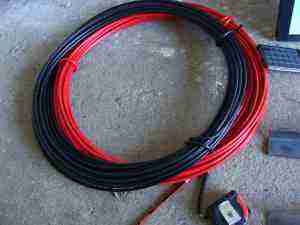
The controller (MPPT)
Maximum power point tracker
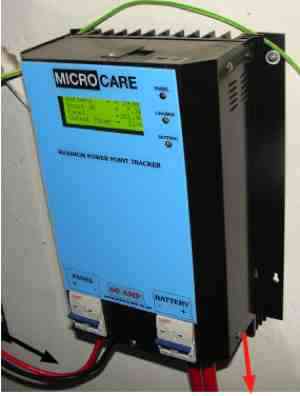
The maximum power point tracker is a regulator that prevents batteries from being overcharged and damaged; a vital part of your solar generator. The function of the MPPT is also to change the incoming voltage from the PVs to that of your batteries and, when they are fully charged, to turn off the incoming energy; it tracks and maximises your panels, increasing their efficiency by at least a third; you can't do without it.
If you go away on holiday for a week, without a regulator, your batteries would be cooked when you got back; a vital piece of the equipment.
Your car also has one to protect the battery from being overcharged by the alternator.
We'll talk more about the controller on another page later, but go as big as you can. I started with a 20 amp regulator, and soon realised it was too small for my newly ambitious needs, and upgraded at considerable cost to a 60A MPPT. And I am now thinking perhaps I should have gone bigger still!
But do yourself a favour. Don't go less than 60A, except for a very specific purpose. For example I knew I was not going to add more mobile panels; the 20A MPPT was adequate.
In fact rather than going to a 100A maximum power point tracking device, the advice I've received is to install two separate 60 amp MPPTs. Since adding the west facing solar panels, that is what I have done.
Another reason is that clouds cause a solar lens effect which can temporarily increase the amps by as much as 50%.
Depending on various factors that we'll discuss later, the regulator will reduce the voltage from your array of PV, and simultaneously increase the amps; the current.
I started with six PVs in series; we'll talk later about different ways of linking of batteries and panels. Each provides about 16V, around 100 volts in total.
The regulator must step that down to the voltage of your batteries, 24V in my case. I would go straight to 48 volts if I was you.
This MPPT will handle up to 150V. So, my six panels provide around 100, but, if it is a bright, mid-summer's day, and the batteries are fully charged, the incoming voltage will surge to around 123. So, I could put a seventh PV in series, but more would go periodically over 150 and perhaps cook the MPPT. Talk to your supplier.
Since the upgrade to a 48V inverter, it's interesting that the MPPT can extract more energy from the photo voltaic panels.
On the 24V system, the energy supplied by the panels was 450W. Now the energy supplied goes over 600 watts. Ad nauseum, I repeat, go as big as you can from the start. Everything is more efficient. And more costly but worth it in the long run.
As I review this page 12 years later I again realise that building a Mickey Mouse solar farm was a huge, costly mistake. Go big from the beginning. I now have 12kW of panels. Back then I was so happy to have 600 watts!
A bit of simple physics to fully understand C
Power (measured in watts) = volts x amps (or VA)
Say my PV panels are providing on one sunny day 400 watts of of direct current power, at 100V and 4A. This energy is travelling along the copper cables to the regulator, but the MPPT must now drop the voltage down to that of the batteries (24V initially); about a quarter.
So the regulator will turn that 400W (at 100V and 4A) into 400W of still direct current (DC) at 24V and about 16A.
The voltage drops by a quarter, the amperage goes up four times, but the power remain the same at 400 watts being provided from the PV.
You may say, so what, do I really need to know this? Yes! Why? Later, when we talk about losses in energy along the pathway, we'll see that the lost watts are dependent on the current (amps), but not the voltage.
So there are big losses between the regulator and the batteries, because of the very high current, unless those cables are short, less than a metre; and as thick as possible.
Have you got it? The cables at C (refer to the diagram above) must be SHORT AND THICK. Because the current is high and we want to minimise the losses (as heat) in the wiring.
Those losses
Minimising the losses in your solar powered generator is absolutely vital. They can be very significant, and demoralising; but it need not be so if you follow these guidelines.
The energy losses in the cables follow the formula known as Joule's first law.
Heat generated = (amps) squared x (resistance) x (time)
So keeping the amps and the resistance of the wires low is vital; and especially the current, since it's squared.
How do you keep the amps low?
Surely you want as much current as possible! Nope. You want as much power (watts, remember) as possible. And since Power = (amps) x (volts), if you raise the voltage at A as high as possible, then you can have low current (amps) and still oodles of watts.
PVs in series for your solar powered generator
Like I said we'll discuss series and parallel later, but simply put, if you put a number of PVs in series, the voltage is additive. More panels, higher voltage, lower current, less losses.
I have six 18V panels in series for my solar powered generator, and now in the upgrade another four 28V panels. So they provide a voltage of about 18 x 6 ± 112V. It varies. Right now some very high cirrus is creeping across the sky (rain tomorrow), it's 15.00 so the voltage and watts are dropping. 180W, 90V and 2A to be precise. I've just checked! To be sure the batteries are full tonight, I've just moved the fridge back to the grid. A more sophisticated system will do this automatically. More about that later, too.
At noon, the power was over 400W, the voltage around 105V providing around 4A. Still high voltage, low amperage, exactly what we want. (Since the upgrade with the second string of panels, there's figures have increased, but the principle remains the same. High voltage and lower current.
How diodes work
Understanding how diodes work is important if you have different panels in your solar powered generator.
Tip: PV's are getting bigger and bigger, and the cost per kW is coming down. Buy the biggest panels you can, and ask if they'll still be available in one year. If you want to upgrade, and they have a different voltage (likely, since the PVs are sourced from all over the world. My first were from South Africa, then German PV's were cheaper, now the new 235W are from Canada!)
So you will need a stud diode to prevent one panel forcing the current backwards in one of the other strings. How diodes work will help you understand this; perhaps not included in high school physics.
Sometimes on a small system powering say a 12V gate motor, you may decide not to use a regulator; there's always the danger of overcharging your battery. Here's a different take on how diodes work.
Step B: The grid
In many developed countries, where the power supply is reliable and clean (having neither voltage spikes nor brown outs - drop in voltage - which can seriously affect the electric motors such as needed to drive your fridge) your solar powered generator is able to transfer any surplus energy back into the grid. Basically, it turns your meter backwards.
However, in South Africa, it's not legal, though I believe some people do it anyway. The problem being that, if the power is off for maintenance, you may electrocute a technician unless you have a dinkum grid tied inverter.
The big advantage: no batteries to store your power.
A big disadvantage: The downside is that you cannot draw power from your own generator, even if the sun is shining, if the grid goes down.
A city electrical engineer tells me that grid tied inverters are causing huge problems world wide. Already some states in the USA have banned pumping your surplus back into the grid; my manual generator is the perfect compromise.
The other problem, as in South Africa, is that the grid may pump dirty electricity back into your pump damaging your equipment; personally I've decided to build a manual system, but still have access to the grid, but they are quite separate.
One of your first considerations is whether to construct a manual or fully automated system. The Solar manual automated debate must be faced.
Fortunately it's coming at a time when huge investment in battery research for electrical cars is making having your own storage for your surplus electrical power a realistic cost effective proposition. The whole scene at solar powered generators is in flux; it's an exciting time.
Step C @ Solar powered generator
Right, the high voltage / low amperage direct current (DC), has arrived at your MPPT which has stepped it down to the emf of your batteries.
The MPPT does it automatically, regardless of whether you have a single 12V battery, two in series (24V) or a 48V system.
Remember, power = volts x amps.
If the voltage has dropped, then the current has surged by an equivalent amount, and that means big losses in Step C. Heat losses = current x (resistance) squared.
There is a solution; the cable between the MPPT and your batteries must be short (less than a metre) and very thick.
Basically the heavy duty cables used in your car to and from the battery. For my solar powered generator, I'm using 50mm cable, but I am told it is overkill; but the increased cost is minimal.
Your batteries
Here I confess I have no expertise, and I recommend you talk to as many local people as possible. Two strong suggestions:
- Get sealed batteries. Otherwise they release highly inflammable hydrogen and must be stored in an open space, preferably outside.
- Avoid "deep cycle lead cell batteries." They can only be drained down to 50% and have a very limited lifespan; perhaps three years.
The batteries are a large part of the expense of your solar powered generator. Hence, if you can "grid-tie" and not have any storage capacity, it will reduce your costs significantly. However, that won't do in South Africa with frequent outages and surges.
Buy the best batteries you can afford. Gel cell, lead crystal and now lithium; expect new developments. It's worth it in the long run.
And even if you have gel cell which in theory you can drain down to zero, try not to go below 50%. You will shorten their lives, though far less seriously than ordinary car batteries.
As you will have realised by now, the losses in the cabling is directly related to the current, not the voltage. Having a high EMF system (24 or 48V) is preferable.
That means you would put two or four 12V batteries in series; or one lithium ion.
These are sealed "lead-crystal" 205Ahr batteries; they are very heavy and damnably expensive but are supposed to last 7 to 12 years. We'll see; they are now five years old, and still perform perfectly. Get help moving them, or you will soon fall into the clutches of your local DCs, and I will be accused of drumming up work for them!
It's now five years down the line and my batteries are still not showing any signs of aging; in fact I have just done an upgrade to four more batteries in parallel.
It's now 12 years since I wrote of this saga; it's been a fascinating journey. Perhaps you just want someone else to come and install a complete system; that is okay but I have had a lot of stimulation and fun.
Now finally we have 11kW of PV panels and two large lithium ion batteries totalling 14.8kWh. We draw from the grid only very occasionally to heat water for baths and showers. Less than R200 per year; that's $10. There are no line charges; we use prepaid electricity.
I wish I had been compelled to face the 12-24-or-48V solar generator question from the start. Do yourself a big favour; go high despite the fact that you must have more batteries, rather than the Mickey Mouse two you can see below; you won't be sorry. If you do not you will be making an unnecessarily expensive upgrade in a few years. In fact, go straight to lithium ion.
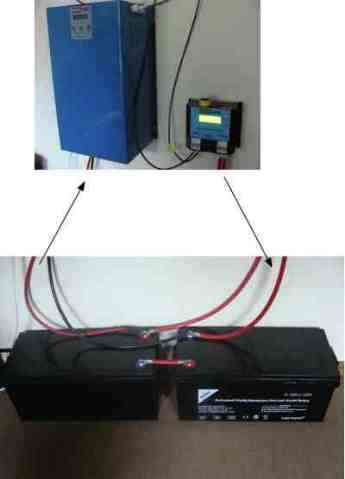
Having large batteries and cables exposed like this is very dangerous if you have prying fingers around. I've now finished building the stairs in our new home, and the space underneath makes the perfect secure, cool resting place for a solar powered generator. Keep the door locked if you have little mites running about.
It should have a smoke detector and a fire extinguisher. Now I'm considering a knife fuse to isolate the batteries in the case of a short circuit.
The knife fuse is purchased, but not yet installed. I've chosen a 125A model which limits the batteries to
48V x 125A = 6 kW
Although the inverter will deliver 10kW we simply don't need that amount of power at any one time; so I am being conservative. It is not an expensive device and it would be simple to increase the fuse to 160A for a few dollars.
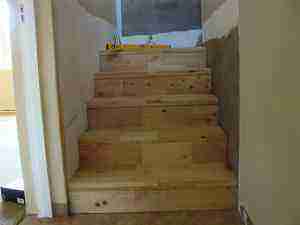
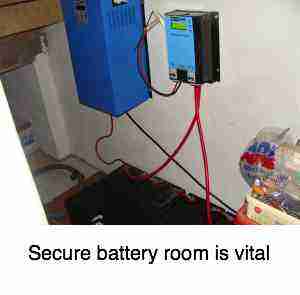
The battery room must be well-ventilated or it becomes very warm in there; too hot for all the equipment.
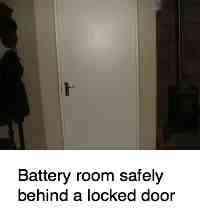
Step D @ Solar powered generator
Right so now your solar energy has been successfully stored in two or more batteries. This is a 24V system, with a couple 12V cells in series.
Step D is the passage of 24V, high amperage direct current (DC) from where it has been stored in your batteries to the inverter.
Again, short, thick cables.
I've just upgraded by adding two more batteries to a 48V system, and a 5kW inverter. I should have done it in the beginning. Getting free energy from the sun is addictive, and like chocolate you just want more.
I've just checked; we have used 207KWh from the grid in five months since installing our basic system. Now, with four more panels and the new batteries and inverter, it will be even less. In fact, I am hoping almost zero. Just my large thicknesser-planar needs a huge amount of energy. And even that might cope, if we turn everything else off.
One doesn't want to stress your system, using it near the limits. The electric oven is no sweat for a big inverter. Go big as you can avoid from the start; then you can avoid the mistake I made and the need to be making a solar-powered generator upgrade.
Aside: You may find this boring, if you have a physics background, but it's a common misconception. Since upgrading from a 24V to a 48V inverter, with four 12V batteries in series, it is noteworthy that the meter shows the current has halved.
Double the voltage, halve the current so there will be half the heat losses.
The inverter @ Solar powered generator
Your inverter is the heart of your solar powered generator. It has one very important function, viz, to turn your 24V direct current into 220V aAC (in SA and Europe), and 110V in the USA and Canada.
Now you can use that solar energy to light your house, run your computers and TV, the fridge, all electric motors. We use it to make coffee and power the bread maker, but only on sunny days because heating uses a lot of energy.
It's an expensive part of your solar powered generator, and I strongly recommend you purchase the best possible quality, with lightning protection and as large as you can. At least 2kW, and I am ruing the day I did not spend the extra and purchase a 5kW or even larger inverter from the start.
We started thinking we would only want solar power for lights and computers when there was a power outage, but quite soon we got hooked. And want to power far more appliances.
Don't buy less than 2kW and, if you can afford it, buy yourself a Christmas present and get a 5kw inverter; or more. The price goes up but it is a good deal less than wanting to trade your current inverter in for a larger model. Do it right the first time. I am sorry I did not.
There are many items, like your hot-water kettle that use around 2kW. A 2kW inverter just isn't adequate for that. Also, electric motors draw a high current for a short time as you turn them on. Bingo, your inverter switches off automatically to protect itself.
So, my advice, a 5kW inverter and, if you have the money, a 10kW. I've just decided to upgrade to 5kW and should have bought the bigger one in the beginning. The 10kW is more than I need.
If you live in South Africa, I can seriously recommend these MicroCare inverters[2]; plus their customer care is impeccable.
When I started building my solar powered generator MicroCare were not yet making grid tied inverters. If were starting now, I would consider it; they enable you to return your excess power to the grid. It would turn the meter backwards, reducing your overall power consumption from the grid; there are big down sides though if you have a dirty grid. I haven't done it, and won't be.
Change Over Switch
Your appliances cannot be simultaneously powered by solar and mains. You will need a change over switch with a neutral between the sources of power; this saves a lot of hassle.
Light emitting diodes
There's only one option if you are going to build a solar powered generator, and that is to buy LED light bulbs. But it is a step you should be taking anyway. Very soon you will not be able to purchase incandescent globes. They use far too much energy and have a limited life span.
Do not get into CF globes; that stands for Compact Fluorescent. They do use much less energy than incandescent, about three times that of LEDs but they contain very toxic mercury; and break very easily in your fingers whilst fitting them. New research is coming out about skin cancer from their light frequency.
Pay the extra, and buy LED. They are reputed to last 15 to 30 years, though who can confirm that? On a high quality, clean electricity system they should be indefinite. But if you have dirty spikes in voltage like we have in South Africa nothing will last.
It's one more good reason to go solar. Rather spend good money on getting clean energy from the sun, than hard-earned dollars buying a new TV or fridge; just because of dirty electricity.
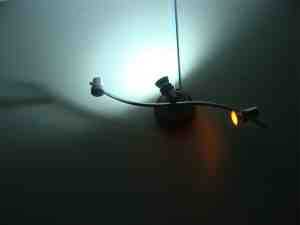
This light fitting above my computer will take three globes. But it's so bright that I have fitted only two, one yellow and the other bright white I have pointed to the ceiling. It is far too brillian pointing straight down. 6W providing more light than incandescent globe; the future is here.
But beware because LED light is different; brighter and harsher. You have to get used to it; try different light fittings, especially those with a lamp shaded. Soft white is available.
Bernard Preston
Bernard Preston has had a lot of fun building this solar powered generator; it is an hour before dawn and he is typing this using the sun's energy stored in batteries, regulated using maximum power point tracking, inverted and turned into 220V alternating current electricity. 110V options exist too obviously.
You must know some basic physics including how diodes work; it's not rocket science but grasping the fundamentals before making a start is vital.

Bernard Preston is an Apple fan for numerous reasons, but not least because they use less than half the energy of a PC. Steve Jobs was adamant because of the noise the fan makes; it did mean their early computers overheated. Anyone using a solar powered generator has to look for devices that draw less current, especially at night when there's no incoming solar power.
If you also have a wind turbine or a hydroelectric device, that's another matter. Bernard Preston has neither.
And so you can use your solar powered generator to drive any number of appliances, especially when the sun is bright. We run the fridge, two in fact, and the dish washer using hot water from the Solar geyser. More about that on another page, but just to say, the water temperature is extremely high, 80 degrees C and more on a bright summer's day.
It may seem unbelievable, I can hardly believe it, but we have used less than one hundred kWh of energy in three months from the grid. All the rest comes from the sun. And now 12 years later with the extra power less than R200 per year.
But yes, we are careful. You don't leave the TV on all day, you put your computer to sleep when not in use, and the iron? Well, that was ditched an age ago. A wood furnace for heating, an induction stove for cooking and vacuum tubes for hot water; and no air con during the night.
Good luck, have lots of fun. I have. Except for climbing around in the ceiling putting in new cables. That was hard work!
How does solar energy work? It's fantastic.
Installation of the panels
If you possibly can, build your arrays of panels on the ground where it is easy to adjust them for summer and winter but often this is impossible in a built up area because of limited space and shading. Installation of PV panels for your solar generator isn't really difficult, if you have two right hands.
One new development is the thought that we should have at least some of them pointing west; they may be less efficient, but provide energy in the later afternoon when we need it most, and some east facing solar panels too for your early morning coffee.
Remember that the sun sets far south in the summer here in Hilton. The west-facing panels are proving far better than initially expected.
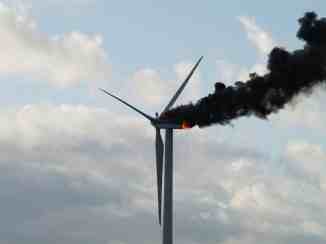
Wind turbines
You need consistently strong winds to make a wind turbine effective. In our area they are a dead loss. I have no experience of them, so look elsewhere, I'm afraid.
The cost of a Solar Powered Generator?
I'm sure it varies enormously depending on where you live, and who you deal with. To date I have spent about $4000 but a third of that is for the batteries. But I am about to add considerably to that to upgrade my solar powered generator to 48V, an extra panels and a 10kW inverter.
Go as big as you can from the very start. I wish I had.
I am sure you could spend double that, and more, to have a professional design and fit your system. Don't do it yourself unless you are serious about learning the basics; talking to people, reading and bending your back, whilst crawling around in the ceiling. Seriously, you can electrocute yourself and destroy the expensive components. To date, I am alive and well and having a ball building this solar powered generator.
Update: It's now 12 years since I installed this Solar powered generator myself and if anything, I am even more enthusiastic than ever. I will admit, it is pure greed. I just love getting a free gift, especially from Mr Golden Sun. You could too.
Just last month I put up three of the new giant 545W panels together with a friend. But I am not recommending that others at 75 should be doing that; it's only for the crazies!
Actually it's for those who belong to the Cyan Zone philosophy; caring for both ourselves and the planet. Eat right, keep busy and active, looking forward to a vigorous and zestful ninety plus.
Induction heating
A big new advancement is the induction cooktop stove.
These are all items that need replacing periodically in the home; they use less than half the energy and provide energy at twice the speed. Instant heat, much faster than gas at the hob is a joy for those who love to cook. Also the stove top doesn't get hot.
Induction stoves are dropping in price as they become more popular. I paid only $40 for second model and it provides 2kW of instant heat. They only work with iron or steel-bottomed pots.
Harvesting energy from the sun gets you into a lot of new innovations too; it's just one more thing that gets me excited about a home solar powered generator.
When browsing use right click and "Open Link in New Tab" or you may get a bad gateway signal.
Lettuce
Plants of course can trap the sun's energy a lot more effectively than we can with our photo voltaic panels; they are little solar powered generators! And then they make that food available to us. Those lettuce wraps recipes are so easy when you know how to grow greens,; deliciously fresh and crisp straight from the organic garden.
This is all about our philosophy of backyard permaculture; working with nature, rather than against it. It's proving very painful but we never can win in the long run if we do not care for Mother Earth. She is the hand that feeds us; and biting us back as we increasingly abuse her.
Did you find this page interesting? How about forwarding it to a friendly book or food junkie? Better still, a social media tick would help.
- Bernard Preston homepage
- Solar
- Solar Powered Generator
Address:
56 Groenekloof Rd,
Hilton, KZN
South Africa
Website:
https://www.bernard-preston.com